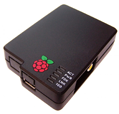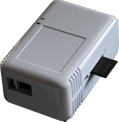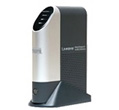Difference between revisions of "Hardware Overview"
| Line 5: | Line 5: | ||
===Raspberry PI Model B and B+ and Model 2 and Model 3 (Models | ===Raspberry PI Model B and B+ and Model 2 and Model 3 (Models 3B and newer are not supported)=== | ||
[[File:rpi-w119.png|right]]Raspberry PI is probably the most widely sold embedded development platform. By putting a prepared SD card into it the Raspberry PI boots as a Meteohub device. Setup instructions are given [http://wiki.meteohub.de/Setup_RPI here]. As the RPI is lacking an onboard real time clock it can take a minute after boot until the local time has adapted to the data from time servers in the internet and data logging is halted until this time update has been done correctly. Power demand is a bit below 5 watts (without weather station). Main features of Mini X are: | [[File:rpi-w119.png|right]]Raspberry PI is probably the most widely sold embedded development platform. By putting a prepared SD card into it the Raspberry PI boots as a Meteohub device. Setup instructions are given [http://wiki.meteohub.de/Setup_RPI here]. As the RPI is lacking an onboard real time clock it can take a minute after boot until the local time has adapted to the data from time servers in the internet and data logging is halted until this time update has been done correctly. Power demand is a bit below 5 watts (without weather station). Main features of Mini X are: | ||
* Broadcom BCM2835, 700MHz, 697 BogoMIPS, 512/256 MB RAM. | * Broadcom BCM2835, 700MHz, 697 BogoMIPS, 512/256 MB RAM. | ||
Latest revision as of 12:58, 28 September 2021
A Meteohub system consists of Meteohub software, which can be downloaded from the website, and suitable hardware. "meteohub.de" just provides software and documentation. Hardware must be purchased separately. Installation of software on hardware is supported by a step-by-step documentation in the Meteohub manual, that can be downloaded from this site. When you are looking for a turn-key system and don't want to go the "install-it-yourself" approach, please contact one of the listed Meteohub distributors, that are specialized on bundled Meteohub solutions.
Meteohub distribution from "download" section can be easily installed with a few steps on the following platforms. Please understand that for capacity reasons "meteohub.de" does only provide support for installation on these "official" platforms only.
Raspberry PI Model B and B+ and Model 2 and Model 3 (Models 3B and newer are not supported)
Raspberry PI is probably the most widely sold embedded development platform. By putting a prepared SD card into it the Raspberry PI boots as a Meteohub device. Setup instructions are given here. As the RPI is lacking an onboard real time clock it can take a minute after boot until the local time has adapted to the data from time servers in the internet and data logging is halted until this time update has been done correctly. Power demand is a bit below 5 watts (without weather station). Main features of Mini X are:
- Broadcom BCM2835, 700MHz, 697 BogoMIPS, 512/256 MB RAM.
- Meteohub software and data provided on 8 GB SD card (minimal recommended size).
- system starts automatically when power is present.
- Integrated LAN, but no integrated WLAN.
- two USB ports that can handle any USB 2.0/1.x devices.
- separate power plug feeding RPI with 5V via Micro USB connector.
- HDMI (full size) port for connection of a monitor (not supported by Meteohub)
- recommended SD Card: Transcend TS16GSDHC10
- Price $55 (without SD card).
New model 2 which uses a much faster multi-core processor is supported since Meteohub image v5.0f.
Turn-key ready Meteohubs based on Raspberry are not available from any Meteohub reseller at the moment, but setup is really simple.
SheevaPlug (out of production)
SheevaPlug from GlobalScale Technologies is a well performing ARM computer in form factor of a power supply. Weather stations are connected via USB, software and data are provided on a SD card. SheevaPlug needs just 5 watts, comes in a tiny package at a cheap price and performs much better than NSLU2 and can be considered as THE sucessor of NSLU2. Main features of SheevaPlug:
- ARM Processor (Kirkwood chipset), 1.2 GHz, 1200 BogoMIPS, 512 MB RAM.
- Meteohub software and data are provided by SD card.
- System starts automatically when power is present.
- no WLAN, no PCI-Bus.
- one USB port, which can be multiplied with external passive USB hub.
- integrated power supply that ranges from 110-240 volts.
- no keyboard, no monitor.
- Price $99 (without SD card).
ALIX.1D (out of production)
ALIX.1D board from PC Engines is based on AMD Geode LX800 processor (500 MHz clocked) like fit-PC Slim. Adding the appropriate black metal case and a DC adapter the ALIX.1D acts as a cheap Meteohub platform that can even be equipped with an optional WLAN adapter (internal mini-PCI slot) and has similar power like a fit-PC Slim, but comes at a significant larger form factor and without status LEDs and without a power switch. CF card, that has to be mounted internally and cannot be accessed from the outside, is used as storage media. Like ebox 4300 and fit-PC Slim the ALIX.1D is well suited to process larger amounts of weather data. Main features of ALIX.1D are:
- x86 system based on AMD Geode LX800 (486 compatible), 500 MHz, 1000 BogoMIPS, 256 MB RAM.
- Meteohub software and daten are stored on (internal) CF-Karte.
- System starts automatically when power is present.
- optional WLAN by mini-PCI slot.
- integrated RS232 interface.
- Price about $180 (without WLAN, without CF card, incl. case and power supply, incl. VAT).
ALIX.1D can be purchased from Varia-Store as a turn-key solution (Germany).
ALIX.3D2 (ALIX.3D3) (out of production)
ALIX.3D2 board from PC Engines is based on AMD Geode LX800 processor (500 MHz clocked) like ALIX.1D, but is lacking a keyboard and monitor connector. This makes the board a bit cheaper and also smaller. These are a number of interesting outdoor cases available for ALIX.3D2. Adding an appropriate small silver metal case and a DC adapter the ALIX.3D2 acts as a cheap Meteohub platform that can even be equipped with an optional WLAN adapter (internal mini-PCI slot). Computational power is identical with ALIX.1D. CF card, that has to be mounted internally and cannot be accessed from the outside, is used as storage media. Main features of ALIX.3D2 are:
- x86 system based on AMD Geode LX800 (486 compatible), 500 MHz, 1000 BogoMIPS, 256 MB RAM.
- Meteohub software and daten are stored on (internal) CF-Karte.
- System starts automatically when power is present.
- optional WLAN by mini-PCI slot.
- integrated RS232 interface.
- no VGA connector, no keyboard connector (ALIX.3D3 has VGA connector, USB keyboard can be connected).
- Price about $150 (without WLAN, without CF card, incl. case and power supply, incl. VAT).
Linksys NSLU2 (out of production)
Meteohub versions 1.x and 2.x supported NSLU2, only. Starting with version 3.0 x86 based platforms are supported as well. NSLU is extremely cheap but come with a few disadvantages compared to other platforms:
- In order to use NSLU2 with Meteohub the firmware has to be flashed. This results in a loss of manufacturer warranty for NSLU2.
- ARM Processor clocked at 133 or 266 MHz, accordingly 133 or 266 BogoMIPS, 32 MB RAM
- Meteohub software und data are stored on USB stick. This type of storage can result in data integrity problems on some systems. To fix this changing of USB stick and/or NSLU2 might be necessary.
- Computation of time-compacted data for large sensor arrays and long recording time frames can get quite slow.
- NSLU2 doesn't reboot automatically after power fail.
- NSLU2 has been discontinued by Linksys in Spring 2008. Some Online-Shops might have units available.
- Street price about $100.



